#14: Competitive Consecutive Bus Catching For Beginners
Ed Jefferson is attempting to visit every Mews in Greater London. This week: theatre name bribery, cursed housing estates and Tory pig parts.
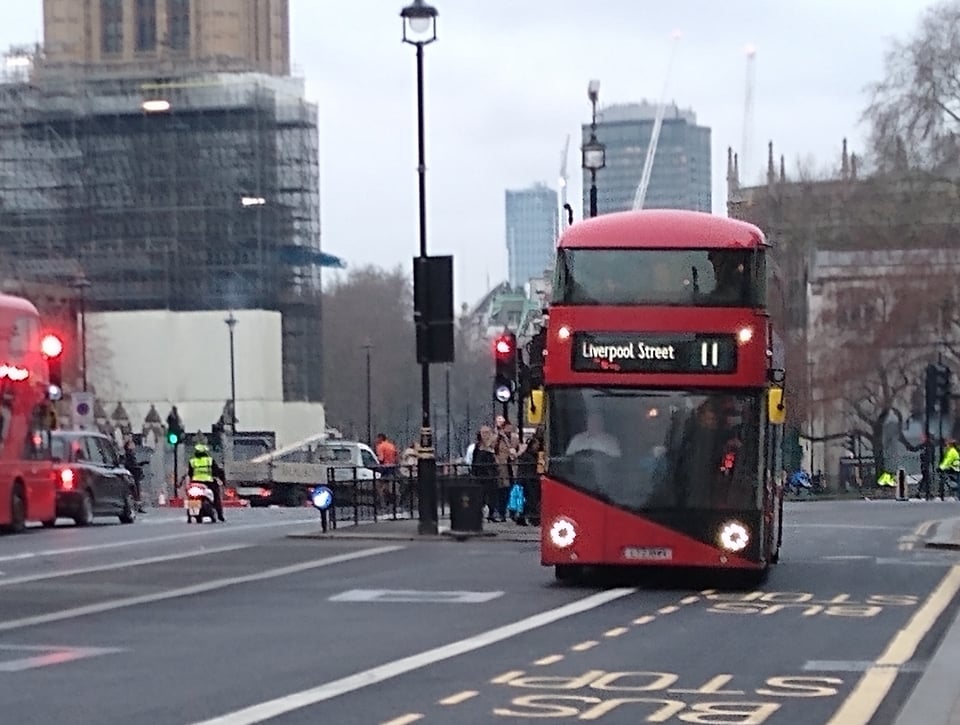
The following was originally written1 back in the pre-COVID times of February 2020, and is reproduced here as plausible ‘backstory’.
I’ve always been vaguely intrigued by the people who set public transport world records – visiting all 270 tube stations in the shortest possible time, say – but not enough to actually compete. After even if I had delusions of grandeur that I could be a competitor, who wants to spend 15+ hours on the tube?
People have attempted similar challenges with London buses, setting records for the number of routes ridden in a day or a week, but that doesn’t feel entirely satisfying either.
Because buses have numbers. Buses have an order.
Let’s do this.
8.30am – Caught the 11 from Parliament Square to Horse Guard’s Parade
Why start with 11? Because the 10 no longer exists, having been brutally murdered by Sadiq Khan/merged with the 23 as part of a probably doomed plan to make Oxford Street less horrible. So what would you do once you’ve got the 9? Stand by the former route of the number 10 crying and throwing flowers into the road? That would be stupid. Starting with the number 11 means that, in theory, you can ride buses in sequence all the way to 71.
8.33am – Caught the 12 from Horse Guard’s Parade to Margaret Street
I planned (well, programmed a computer to plan) my journey by comparing the distances of the stops on numerically consecutive routes to find the closest pair, as the crow flies. In some cases, as with the 11 and 12 this ‘pair’ is actually a single stop served by both buses.
But to get the 13 I had to walk half a mile across town, from which we can conclude that consecutive numbering doesn’t necessarily indicate that the routes have any connection.
8.55am – Caught the 13 from Orchard Street to Hyde Park Corner
So what does the number mean, if anything?
In the early days of motorised buses, the London General Omnibus Company decided to brand one of their routes as “Vanguard” – then added another called “Victory”. Traffic manager George Samuel Dicks presumably realised that a massive error had been made and, instead of launching the Vile, Vague, Vapid and Vasectomy buses, reverted to the Vanguard name and differentiated the routes by sticking discs with numbers on to the sides of the buses.
9.19am – Caught the 14 from Hyde Park Corner to Gerrard St
In 1908 the London General Omnibus Company bought out all its main rivals and consolidated most of London’s bus routes into its numbering system, which ran from 1 to 20, omitting 5 and 12: the system has never made any particular sense.
Much of the 14’s route dates back to this point, when it replaced its predecessor, the T – the London Road-Car Company used letters for its ‘Union Jack’ branded services. Why not write an alternate history novel in which the London Road-Car Company won the bus wars, and now all the bus routes are called “J” and “FH”, and that’s the only difference from our universe?
9.45am – Caught the 15 from Bedford St to Charing Cross
The computer’s directions prompted me to try and get on the 15 at the route’s last stop, where it was throwing everybody out, like some sort of shameful tourist. So I had to walk up the Strand and get the next one in order to get back to where I’d started in the first place.
10.11am – Caught the 16 from Grosvenor Gardens to the London Hilton Hotel
There is logic behind bus numbers – unfortunately, it’s several different types of logic that have been inconsistently applied over the course of more than a century.
In 1924, A. E. Bassom, the Metropolitan Police’s first traffic policeman (and inventor of The Knowledge, black cab fans), came up with a scheme in which the number would indicate the area the bus operated in and/or the type of bus it was. So routes 1 to 199 were central London double deckers, 200 to 289 central London single deckers, and so forth.
Given that portions of the Vanguard numbered routes survive in many of their numerical descendants, we can presume that numbers were only changed when necessary, rather than given a full overhaul. Lazy Bassom.
11.17am – Caught the 17 from Grays Inn Road to York Way
Letter suffixes (W12, P4, etc) originated in an attempt to simplify the once over-complicated fare structures by creating “flat fare” areas. This won’t be relevant to my adventures today, as I don’t think you should be allowed to cross between lettered routes and non-lettered routes for the purposes of completing sequential journeys. But perhaps we can debate this at the first meeting of the longest numerically sequential London bus journey record-keeping committee.
11.37am – Caught the 18 from Euston to Great Portland Street
I didn’t want to go to all the way to Great Portland Street but the two intervening bus stops were closed. There are many unexpected challenges in life, and also in numerically sequential London bus journeys.
12.08pm – Caught the 19 from New Oxford Street to Monsell Road
There is an occasional hazy logic to the individual numbers – for example, the 59 and 159 share the southern portions of their routes. But the 60 and 160 don’t, so is it that helpful a system if the numbers only imply an association some of the time?
Walking down Tottenham Court Road I spot and wave to someone I used to work for years ago, and reflect on a time when I had a real job with a desk and meetings, and didn’t spend all my time thinking about things like bus numbers.
To get from Monsell Road, near Stoke Newington, to the next stop requires a somewhat further trek than I’ve done yet so far, across the Lea Valley.
I see many interesting things, including a nature reserve and a car that hates women.

2.24pm – Caught the 20 from Walthamstow Bus Station to Grove Rd
It seems very important to me that you should have to walk between bus stops rather than using another method, even if this involves spending the best part of four hours walking to Walthamstow and back again to go one stop on a bus.
If this does not seem important to you and you think you should be allowed to use a bike or a train or another bus to get there, perhaps you should try and set your own record for catching London buses in sequential order.
3.59pm – Caught the 21 from Mildmay Grove
The 21 passes pretty close to a convenient route home, so having been at this for nearly eight hours and walked 15 miles in all I decided to call it for my first attempt.
At 11 buses in order, I declare myself the current holder of the record for catching London buses in sequential order (unassisted). If you fancy giving it a go, or believe you have taken a longer sequential route already, please use the hashtag #catchinglondonbusesinsequentialorderunassisted to let me know.
(As this record attempt took place in January 2020, it is possible someone has subsequently beaten this. If you have, write to mews@edjefferson.com and I will send you a certificate or something.)
The Mewses
#131 Cottesloe Mews, Lambeth, SE1

Early 1990s housing development that replaced houses originally facing out onto the surrounding streets, as well as a pub called The Tower.2
I can’t find any obvious reason for the Mews’ name, but it may derive from the Cottesloe Theatre, once part of the National Theatre up the road on the South Bank. Lord Cottesloe was the chairman of the theatre when it opened, but got bumped in 2014 when the venue was redeveloped and reopened as the Dorfman, entirely coincidentally following a donation of £10 million from Lloyd Dorfman, founder of Travelex. Must be nice having a theatre named after you. Can anyone lend me 11 million quid? No reason.
#132 Bedlam Mews, Lambeth, SE11
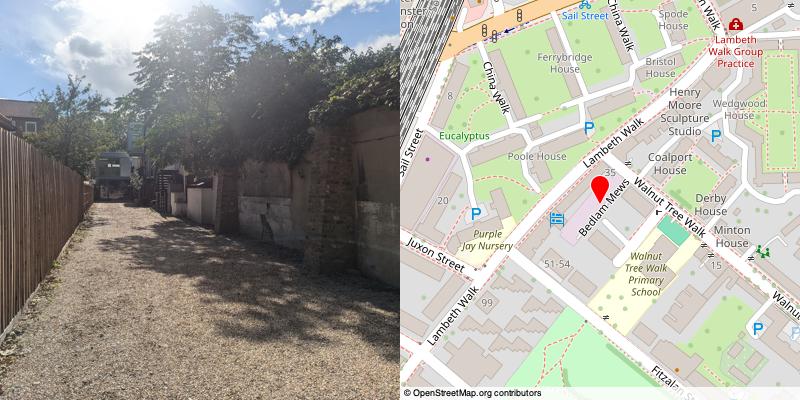
Not clear to me when exactly this got its slightly dubious name, though I suspect it was sometime after the actual Bedlam - Bethlem Hospital (“Lunatic Asylum” as the old maps tactfully put it) was based anywhere near here (the Imperial War Museum took over the former building in the 1930s). Presumably the various businesses based in the Mews all have ‘You don’t have to be crazy to work here etc’ mugs in their kitchens.
#133 Wren Mews, Lambeth, SE11
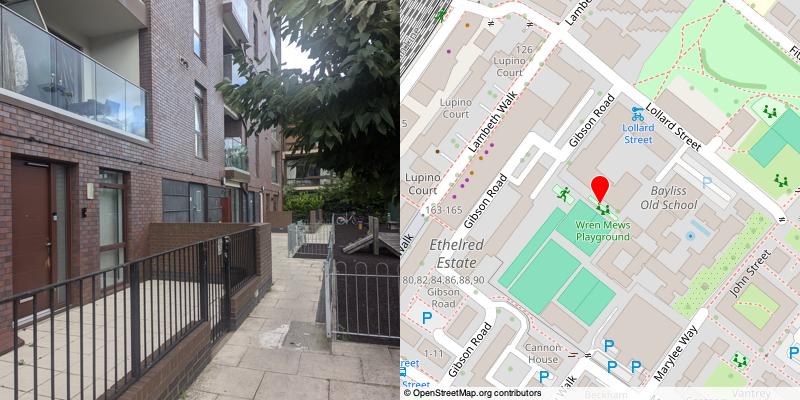
The social housing component of an estate that saw an old school converted into homes in the 2010s, this was briefly newsworthy for unfortunate reasons - the developers segregated the site to stop children in Wren Mews using the playground accessible from the privately-owned housing. After it was pointed out by pretty much everyone (including several newspapers, and, to be fair, residents of said private housing) that this was a) an appalling thing to do and b) had been done without the necessary planning permission, they rapidly backed down and demolished the wall that had blocked access.
#134 Lambeth Mews, Lambeth, SE11
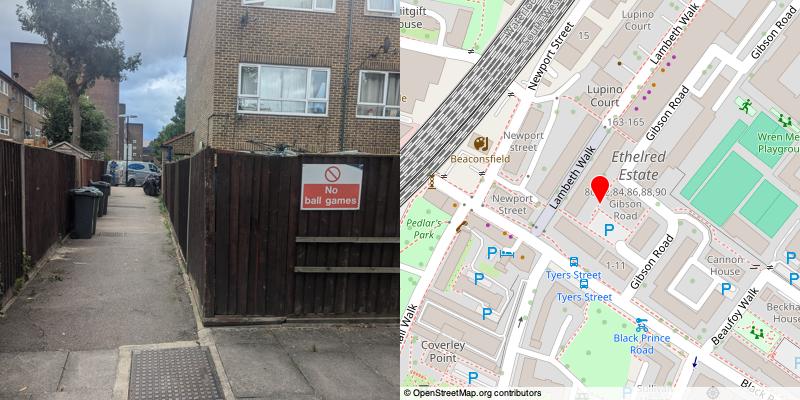
Diminished to the point where it’s debatable whether it exists at all - the Mews used to be a proper road running parallel to Lambeth Mews but when the area was redeveloped into the Ethelred Estate in the 1970s it disappeared - the northern section becoming what is now part of Gibson Road, leaving a footpath with some bins on to be mournfully labelled ‘Lambeth Mews’ on more optimistic maps.
Ethelred Estate used to include a tower called Kerrin Point, until it suffered a rather dramatic gas explosion one night in 1997 - though there were injuries, amazingly no-one was killed. It was demolished and replaced by a shiny new private housing block called Kennington Park Square which was, obviously, completely covered in some of that brilliant cladding that loves to go on fire. Cursed.
#135 Hansom Mews, Lambeth, SE11
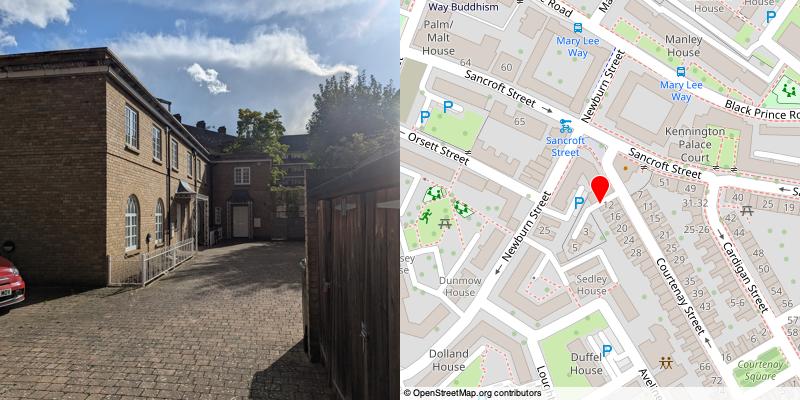
Rather swanky looking bit of infill housing replacing what was until about 10 years some very crappy-looking garages.
The Hansom cab was an extremely popular type of 19th century horse-drawn carriage - the only tenuous local connection I can find is that Vauxhall (the car company, so named because it was originally based up the road in Vauxhall) built a motorised version - essentially a car where the driver sat outside, behind the passengers - as one of their earliest vehicles. Though I can see the downsides with that at least it meant they couldn’t subject you to LBC.
#136 Spring Mews, Lambeth, SE11
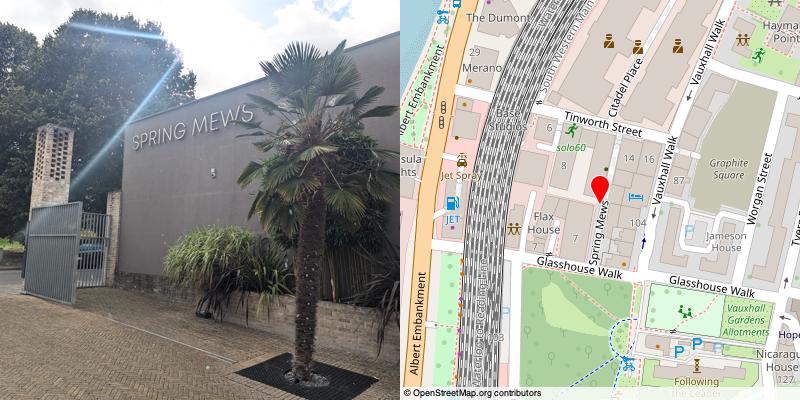
One of those posh student accommodation blocks you get now that are so absurdly expensive that they must be relying on the naiveté of the customer base as much as anything. Always get the vague feeling of something not quite adding up with these places but if I think about it too much I get a headache so I’ll stop now.
The name is a reference to the park to the south, which originated in the 17th century as New Spring Garden, before being developed into the internationally renowned3 Vauxhall Pleasure Gardens a sort of early modern theme park where you could watch fireworks, reconstructions of the Battle of Waterloo, a man ascending in a balloon while riding a horse, etc and eat crap overpriced food. It was eventually flogged off for housing development in the mid-19th century, but the park was restored during slum clearances and Spring Gardens lived again for a bit before being re-renamed as Vauxhall Pleasure Gardens in 2012. I guess ‘Pleasure Mews’ sounded a bit off.
#137 Percival Mews, Lambeth, SE11
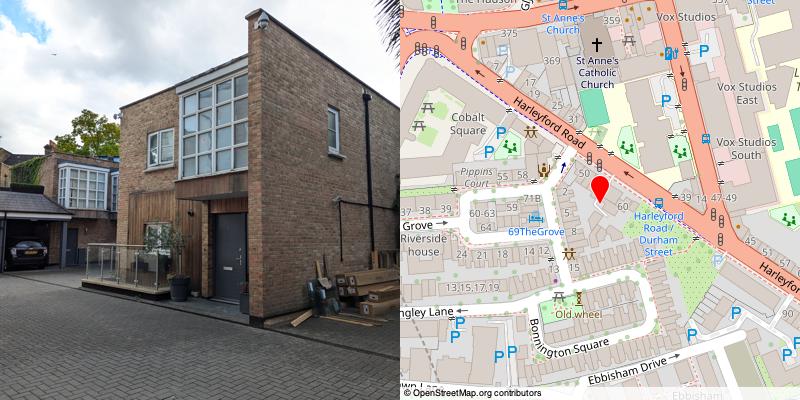
Was for some years a garage for classic cars, having had various other industrial uses. I found a 1969 ad in a newspaper for a shower installation specialists based here, featuring an image of what appears to be a person of colour in a grass skirt standing in front of a shower, with implications that are at best deeply confusing, but probably just stunningly racist.
The planning permission documents include a but that essentially says ‘it went on fire a couple of years ago so you might as well let us build houses’ which, hmm, though it seems a perfectly reasonable bit of infill development anyway.
There was an olden days plane called the Percival Mew Gull that set the world record for travelling from Gravesend to Capetown in 1939 (presumably the theory was that even if you crash, at least you’re not in Gravesend anymore), but sadly I don’t think there’s any connection.
#138 Paragon Mews, Lambeth, SW8
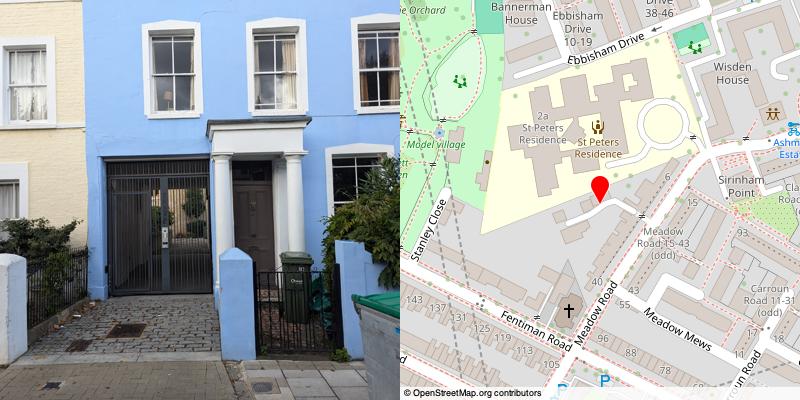
A “contemporary collection” of houses built (in place of some manky old garages) in 2017, it says in this contemporaneous property advert, which like all other property adverts, manages to make houses sound like Pokémon for landlords. The three bed houses in the development each have three toilets in them, so are ideal for people who like going to the toilet.
#139 Meadow Mews, Lambeth, SW8

Surviving stretch of road just south of the Ashmole Estate, parts of which were built over a section of the Mews. Things on the estate have occasionally been addressed as being on Meadow Mews, e.g. in the 1970s the offices of the revolutionary newsletter of the Worker's Institute of Marxism-Leninism-Mao Tsetung Thought listed it as a base of operations (i.e. writing articles about how you are definitely not mad and anyone who says you are is a tool of the fascist state).
The original Meadow Mews was a proper horse-housing mews, and in 1882 two boys were up in court for stealing some of the horses, but were let off with a warning on the basis that they were just copying things they’d read in cheap literature about Dick Turpin. At least they weren’t reading the revolutionary newsletter of the Worker's Institute of Marxism-Leninism-Mao Tsetung Thought, I suppose.
#140 Usborne Mews, Lambeth, SW8

When the streets around the Mews were built the site was originally left open as a private park named ‘The Shrubbery’4 - in 1929 this became the London Terminal Coach Station, from which you could reach any number of south coast holiday destinations offering “Health and Sunshine” according to an 1932 ad, which seems optimistic when you’re talking about such glamorous locations as ‘Worthing’.
Got bombed in the war and afterwards became a car dealership, having always been a fairly crap place for a coach station. In the 1980s was bought and turned into housing by unimaginative name experts Usborne Developments, a property firm funded by Usborne, sellers of grain and pig parts (not to be confused with the publishers). Fun fact: they were so enthusiastic about revolting sacks of meat that they once made Tory wanker Cecil Parkinson their chairman.
Mewses Visited So Far: 140/2380

It was written for the late lamented CityMetric, which, although it notionally still exists under another name, I will not link to, as they appear to have rudely deleted all the bylines, although given they have also inserted apparently AI-generated nonsense into some of the articles in question, perhaps this is a blessing. ↩
The son of one of the pub’s last landlords claims the pub was named after a “Roman tower” that once stood on the site, but this seems probably spurious given the name was at one point The Tower of London. ↩
Tivoli Gardens in Copenhagen was originally named “Tivoli & Vauxhall”, Tivoli (in Paris) and Vauxhall being considered crème de la crème of pleasure gardens. And yet I got cease and desist letters when I tried to open DisneyWorld Alton Towers. ↩
Feel free to make your own entertainment by saying it in the Monty Python voice if you must. ↩
Add a comment: